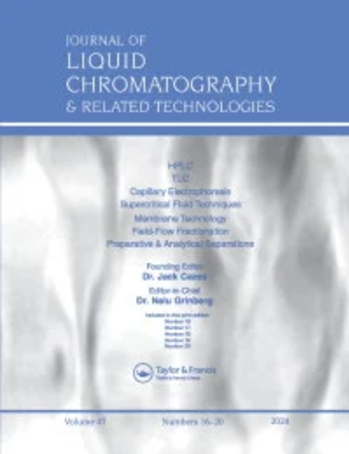Development of UPLC-MS/MS methods for quantitation of glutathione, cysteine, 14,15-epoxyeicosatrienoic acid, and 15-hydroxyeicosatetraenoic acid and application in paraquat poisoning cells
IF 1.2
4区 化学
Q4 BIOCHEMICAL RESEARCH METHODS
Journal of Liquid Chromatography & Related Technologies
Pub Date : 2023-06-15
DOI:10.1080/10826076.2023.2223634
引用次数: 0
Abstract
Abstract Glutathione (GSH) and cysteine are important antioxidants in maintaining the oxidation-reduction balance. 14,15-epoxyeicosatrienoic acid (14,15-EET) and 15-hydroxyeicosatetraenoic acid (15-HETE) are biological active compounds metabolized from arachidonic acid. To dynamically monitor GSH, cysteine, 14,15-EET, and 15-HETE, an ultra-high-performance liquid chromatography-mass spectrometry (UPLC-MS/MS) method was developed. The derivative GSH, cysteine, and underivatized 14,15-EET, 15-HETE were determined by electrospray ionization source with multiple reaction monitoring. The developed method was well validated and applied to monitor the extracellular concentration of GSH, cysteine, 14,15-EET, and 15-HETE in paraquat (PQ) poisoning LO2 cells. It was shown that the derivation of GSH and cysteine is complete and specific. There was a good linear relationship among GSH, cysteine, 14,15-EET, and 15-HETE. The relative standard deviations of precision and accuracy were all within 15%. After PQ poisoning, the extracellular concentrations of GSH and cysteine were increased at 72 h. 14,15-EET and 15-HETE started to increase at 24 h, earlier than GSH and cysteine. Irreversible pathological alterations appeared at 48 h. In conclusion, a fast and specific UPLC-MS/MS method for the determination of GSH, cysteine, 14,15-EET, and 15-HETE has been developed and validated. PQ induced the increase of 14,15-EET and 15-HETE earlier than that of GSH and cysteine in LO2 cells culture medium. Graphical Abstract谷胱甘肽、半胱氨酸、14,15-环氧二十碳三烯酸和15-羟基二十碳四烯酸的UPLC-MS/MS定量方法的建立及其在百草枯中毒细胞中的应用
谷胱甘肽(GSH)和半胱氨酸是维持氧化还原平衡的重要抗氧化剂。14,15-环氧二碳四烯酸(14,15- eet)和15-羟基二碳四烯酸(15-HETE)是花生四烯酸代谢的生物活性化合物。为了动态监测GSH、半胱氨酸、14、15-EET和15-HETE,建立了超高效液相色谱-质谱(UPLC-MS/MS)方法。采用多反应监测的电喷雾电离源法测定衍生物GSH、半胱氨酸和未激活的14,15- eet、15-HETE。所建立的方法得到了很好的验证,并用于监测百草枯(PQ)中毒LO2细胞中GSH、半胱氨酸、14、15-EET和15-HETE的细胞外浓度。结果表明,谷胱甘肽和半胱氨酸的衍生是完整和特异性的。GSH、半胱氨酸、14、15-EET和15-HETE之间存在良好的线性关系。精密度和准确度的相对标准偏差均在15%以内。PQ中毒后72h细胞外谷胱甘肽和半胱氨酸浓度升高。14、15-EET和15-HETE在24 h开始升高,早于GSH和半胱氨酸。48 h出现不可逆的病理改变。综上所述,建立了一种快速、特异的UPLC-MS/MS测定GSH、半胱氨酸、14、15-EET和15-HETE的方法并进行了验证。PQ诱导LO2细胞培养液中14、15-EET和15-HETE的升高早于GSH和半胱氨酸的升高。图形抽象
本文章由计算机程序翻译,如有差异,请以英文原文为准。
求助全文
约1分钟内获得全文
求助全文
来源期刊
CiteScore
2.80
自引率
0.00%
发文量
29
审稿时长
4.9 months
期刊介绍:
The Journal of Liquid Chromatography & Related Technologies is an internationally acclaimed forum for fast publication of critical, peer reviewed manuscripts dealing with analytical, preparative and process scale liquid chromatography and all of its related technologies, including TLC, capillary electrophoresis, capillary electrochromatography, supercritical fluid chromatography and extraction, field-flow technologies, affinity, and much more. New separation methodologies are added when they are developed. Papers dealing with research and development results, as well as critical reviews of important technologies, are published in the Journal.

 求助内容:
求助内容: 应助结果提醒方式:
应助结果提醒方式:


